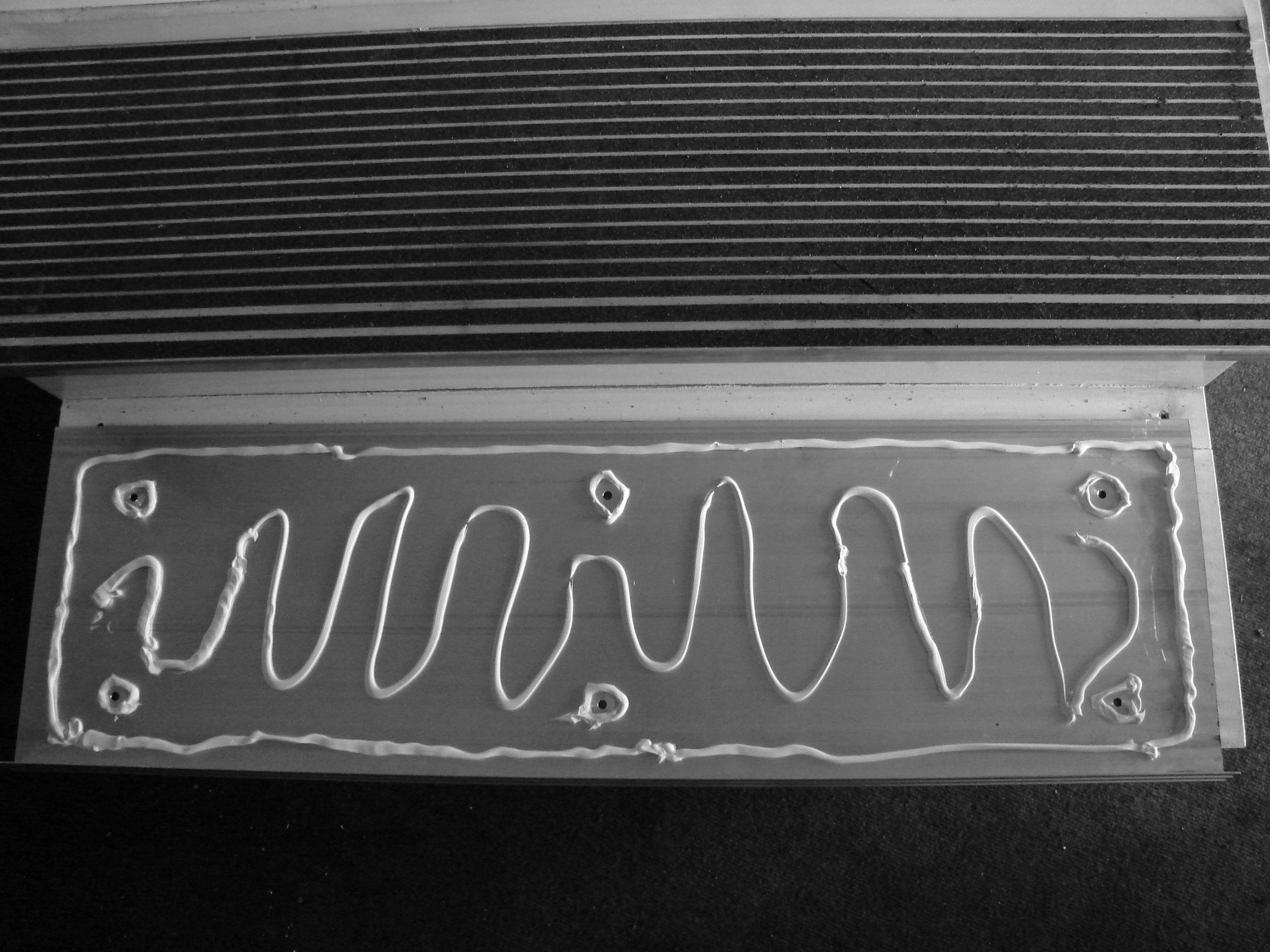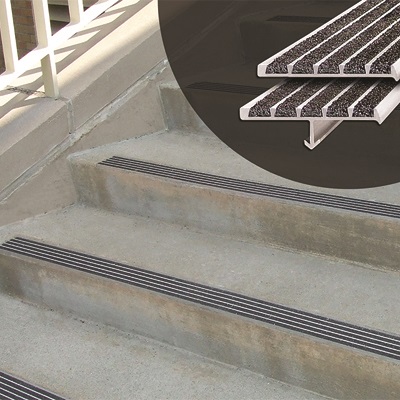INSTALLATION INSTRUCTIONS
Amstep Products increases your ground’s safety factor for all users.
Stair treads installation with Amstep non-slip treads and nosing is simple, especially with the right set of instructions. Use the instructions below for installing our products over concrete, wood, metal, terrazzo stairs, and more. Find instructions for installing stair treads and nosing in poured concrete here.
Installing Treads or Nosing Over Existing Staircases
PREPARATION OF STAIRS:
All stairs must be sound, clean and level prior to installation of Amstep Safety Stair Treads.
An application of leveling compound should be made over dished or worn stairs to provide a level-bearing surface for the safety stair treads. Smooth steps such as marble, terrazzo, tile, metal, etc. should be roughed up to insure good adhesion. Always vacuum clean steps to remove any loose particles. Other types of stair surfaces need only to be thoroughly cleaned. Troweling a leveling compound against a straightedge board held to the front of each step will provide a square edge. Begin at top of stairs and work down. Leave until cured. (See manufacturer’s instructions).
RECOMMENDED FASTENERS AND DRILL BITS:
For CONCRETE and MASONRY stairs, Amstep Products recommends using Tapcon® ¼” x 1 ¾” 410 Stainless Steel Phillips Flat Head Concrete Anchors. Drill pilot holes with a hammer drill fitted with a 3/16” masonry bit, ½” deeper than anchor itself.
For STEEL stairs, Amstep Products recommends using a hardened steel ¼” x 1” Phillips Flat Head Self-tapping Floor Screw. Pilot hole is 13/64”. If you find the selftapping screws are very hard to drive in, you may use a larger drill bit (7/32”) for your pilot holes, but be careful not to strip treads.
For WOOD stairs, Amstep Products recommends a ¼” x 1 ¼” Stainless Steel Wood Screws. Drill pilot holes with a 3/16” drill, at least the depth of the anchor.
TOOLS REQUIRED:
Shop vacuum, caulk gun, extension cord, drill, drill bits and screwdriver. For masonry installations: shop vacuum, caulk gun, extension cord, hammer drill, 3/16” masonry bits and screwdriver.
STAIR TREAD INSTALLATION INSTRUCTIONS:
- Block off access to the stairway you will be working on to keep people out of the area. Put up signs and danger tape;
- Begin at bottom stair. Carefully lay stair tread upside down on the stair;
- Apply a ¼” bead of glue all the way around the perimeter of the bottom side of the tread, keeping approximately ¾” away from the outside edge of tread. Apply an additional ¼” bead in a wavy pattern on the remainder of the bottom side of the tread inside the perimeter bead, as well as a ¼” bead around each predrilled hole approximately ½” from the hole. (See Figure A to the right).
Note: For exterior installations, substitute clear GE Silicone caulk instead of glue. - Carefully pick up, turn over and place tread on stair;
- Push down on tread to distribute glue or caulk;
- Be sure ends of tread are equally spaced on stair and that tread is pushed back as far as it will go against front edge;
- Using a shop vacuum, hold end of vacuum hose as close as possible to the predrilled hole(s) in the tread in order to vacuum up dust and drillings from hole and tread;
- Carefully drill the first hole toward the center of the tread;
- Vacuum out all dust and debris from hole;
- Screw in and tighten anchor. CAUTION: Using a power driver can strip the fastener. If you use a power driver, use the clutch to help prevent stripping;
- Drill and anchor another hole on either end of the tread;
- Drill all remaining holes and anchor them;
- Repeat the process for remaining stair treads


Installing Treads or Nosing in Poured Concrete
- Pour the concrete to form stairs. Schedule pours to allow safety stair treads to be installed quickly before initial set occurs. Make sure you have the required number of safety treads before pouring concrete. WARNING: THE USE OF VERY LARGE AGGREGATE OR CONCRETE WITH A VERY LOW SLUMP WILL MAKE INSTALLATION OF THE STAIR NOSING DIFFICULT.
- Select one of the stair nosings and place the nosing, with attached anchors, into the fresh concrete. Ensure that the front edge of the nosing is flush with the riser form or at the dimension indicated on the architectural drawings.
- Gently work the nosing into the concrete until the back edge of the nosing is level with the finished edge of the tread. Work the nosing into the concrete until it is level, plumb, flush with the tread, and at the proper elevation. To provide a stable installation ensure that the stair nosing anchors are securely set in the concrete and that the concrete is completely surrounding them.
- Repeat the procedures given in Step 2 and Step 3 above until all the stair nosings are installed and properly positioned.
- After the concrete has taken its initial set, remove the riser forms and finish the concrete riser flush to the stair nosing front or as otherwise specified. This is important to ensure that the riser has a clean finish.
- Stairway must be closed for a minimum of twenty-four (24) hours or until concrete has cured.

